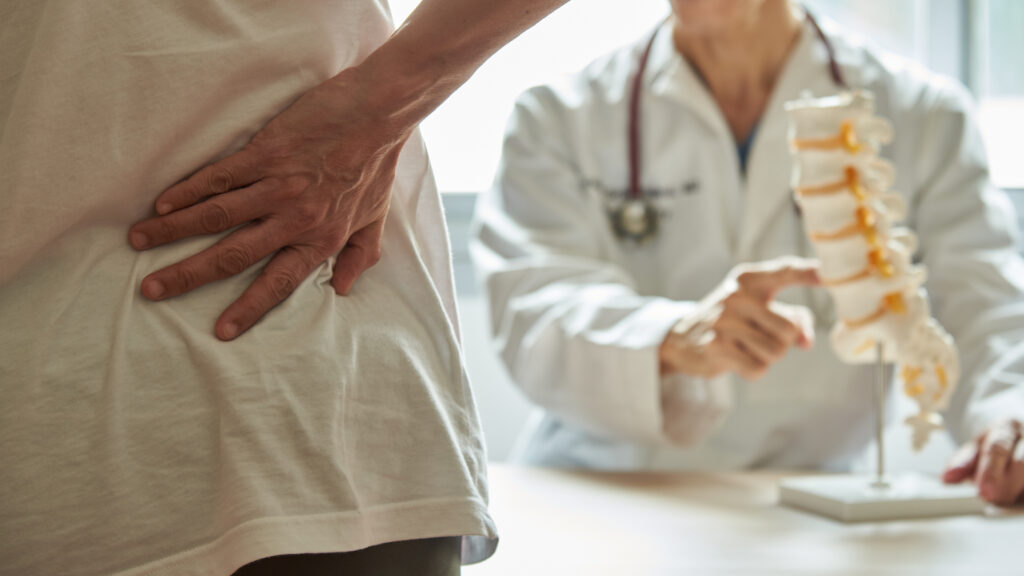What is Degenerative Disc Disease?
Your spine is made up of 33 individual bones called vertebrae, stacked vertically with flexible cushions (intervertebral discs) between them. These discs have two main components:
- The tough outer layer (annulus fibrosus), made of crisscrossing fibrous tissue.
- The soft inner core (nucleus pulposus), a gel-like substance that absorbs shock.
Degenerative Disc Disease (DDD) is a natural aging process where these soft, cushion-like structures between your vertebrae gradually wear down over time. These discs act as shock absorbers, allowing flexibility in your spine. As they degenerate, they lose hydration and elasticity, which can lead to pain, stiffness, and reduced mobility.


Why Do Discs Degenerate?
Several factors contribute to disc degeneration:
- Aging: Discs naturally lose water content over time, making them less flexible.
- Wear and Tear: Repetitive stress from daily activities, sports, or heavy lifting.
- Injury: Trauma (such as a fall or car accident) can accelerate disc damage.
- Genetics: Some people inherit a predisposition to early disc degeneration.
- Lifestyle: Smoking, poor posture, obesity, lack of exercise, and occupations involving heavy lifting and vibrations may all speed up disc degeneration.
Common Symptoms
Not everyone with DDD experiences pain, but when symptoms occur, they may include:
- Chronic back or neck pain that comes and goes.
- Stiffness, especially after sitting or sleeping.
- Pain that worsens with bending, lifting, or twisting.
- Numbness or tingling as well as pain in the limbs if nerves are affected (radiculopathy).
- Muscle weakness in severe cases.
How is DDD Diagnosed?
Your doctor may use:
- Medical history & physical exam (checking range of motion, reflexes, and pain triggers).
- Imaging tests (X-rays, MRI, or CT scans) to assess disc height and nerve compression.
- Discography (rarely) to identify painful discs.
Treatment Options
Non-Surgical Treatments (First Line of Care)
- Physical Therapy: Strengthens core and back muscles to support the spine.
- Medications: NSAIDs (ibuprofen), muscle relaxants, or nerve pain medications.
- Lifestyle Changes: Weight management, quitting smoking, and proper posture.
- Heat/Ice Therapy: Reduces inflammation and muscle spasms.
- Epidural Steroid Injections: For severe nerve pain.


Surgical Options (If Conservative Treatments Fail)
- Laminectomy/Discectomy: Removes part of a damaged disc or bone pressing on nerves.
- Spinal Fusion: Joins vertebrae to eliminate painful movement.
- Artificial Disc Replacement: Preserves motion by replacing the damaged disc.
Living with DDD: Prevention & Management
- Stay Active: Low-impact exercises (swimming, walking, yoga).
- Strengthen Core Muscles: Supports the spine and reduces pressure on discs.
- Improve Posture: Avoid slouching when sitting or standing.
- Use Proper Lifting Techniques: Bend at the knees, not the waist.
- Stay Hydrated: Discs need water to maintain cushioning.
Outlook & Recovery
While disc degeneration is irreversible, most people manage symptoms well with conservative treatments. Surgery is only considered if pain is disabling and other methods fail. With proper care, many remain active and pain-free for years.
Our experienced team of healthcare professionals will guide you through your healing. Schedule a consultation with us today.
